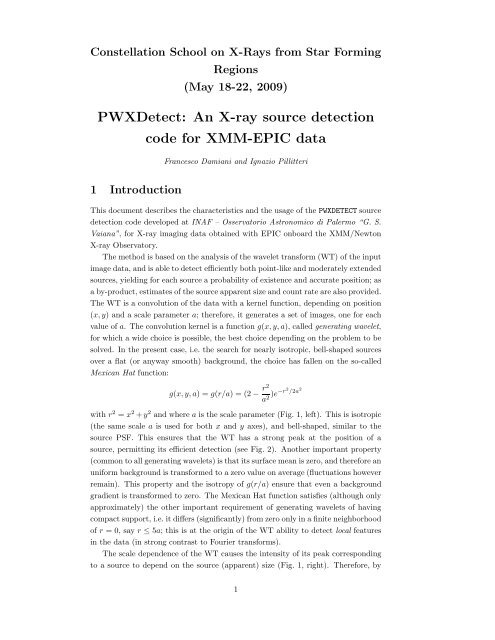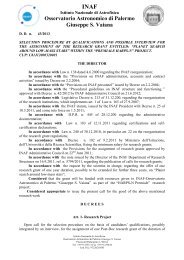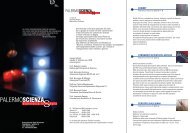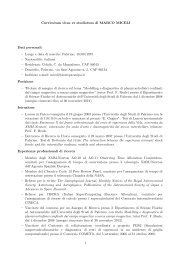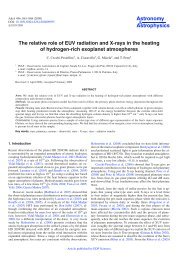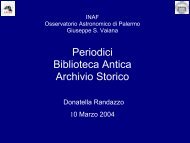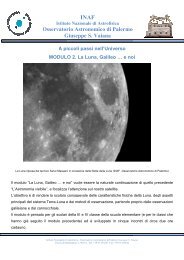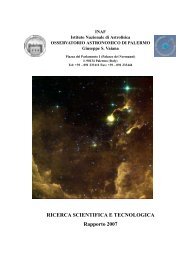Wavelet detection method for XMM - Osservatorio Astronomico di ...
Wavelet detection method for XMM - Osservatorio Astronomico di ...
Wavelet detection method for XMM - Osservatorio Astronomico di ...
Create successful ePaper yourself
Turn your PDF publications into a flip-book with our unique Google optimized e-Paper software.
Constellation School on X-Rays from Star FormingRegions(May 18-22, 2009)PWXDetect: An X-ray source <strong>detection</strong>code <strong>for</strong> <strong>XMM</strong>-EPIC dataFrancesco Damiani and Ignazio Pillitteri1 IntroductionThis document describes the characteristics and the usage of the PWXDETECT source<strong>detection</strong> code developed at INAF – <strong>Osservatorio</strong> <strong>Astronomico</strong> <strong>di</strong> Palermo “G. S.Vaiana”, <strong>for</strong> X-ray imaging data obtained with EPIC onboard the <strong>XMM</strong>/NewtonX-ray Observatory.The <strong>method</strong> is based on the analysis of the wavelet trans<strong>for</strong>m (WT) of the inputimage data, and is able to detect efficiently both point-like and moderately extendedsources, yiel<strong>di</strong>ng <strong>for</strong> each source a probability of existence and accurate position; asa by-product, estimates of the source apparent size and count rate are also provided.The WT is a convolution of the data with a kernel function, depen<strong>di</strong>ng on position(x, y) and a scale parameter a; there<strong>for</strong>e, it generates a set of images, one <strong>for</strong> eachvalue of a. The convolution kernel is a function g(x, y, a), called generating wavelet,<strong>for</strong> which a wide choice is possible, the best choice depen<strong>di</strong>ng on the problem to besolved. In the present case, i.e. the search <strong>for</strong> nearly isotropic, bell-shaped sourcesover a flat (or anyway smooth) background, the choice has fallen on the so-calledMexican Hat function:g(x, y, a) = g(r/a) = (2 − r2a 2 )e−r2 /2a 2with r 2 = x 2 + y 2 and where a is the scale parameter (Fig. 1, left). This is isotropic(the same scale a is used <strong>for</strong> both x and y axes), and bell-shaped, similar to thesource PSF. This ensures that the WT has a strong peak at the position of asource, permitting its efficient <strong>detection</strong> (see Fig. 2). Another important property(common to all generating wavelets) is that its surface mean is zero, and there<strong>for</strong>e anuni<strong>for</strong>m background is trans<strong>for</strong>med to a zero value on average (fluctuations howeverremain). This property and the isotropy of g(r/a) ensure that even a backgroundgra<strong>di</strong>ent is trans<strong>for</strong>med to zero. The Mexican Hat function satisfies (although onlyapproximately) the other important requirement of generating wavelets of havingcompact support, i.e. it <strong>di</strong>ffers (significantly) from zero only in a finite neighborhoodof r = 0, say r ≤ 5a; this is at the origin of the WT ability to detect local featuresin the data (in strong contrast to Fourier trans<strong>for</strong>ms).The scale dependence of the WT causes the intensity of its peak correspon<strong>di</strong>ngto a source to depend on the source (apparent) size (Fig. 1, right). There<strong>for</strong>e, by1
Figure 4: Examples of exposure map (left panel), and extrapolated border (rightpanel) <strong>for</strong> the pn detector.3.2 CCD Gaps and EdgesDifferently from ROSAT and Chandra data, the images obtained with the EPICcamera are characterized by sharp gra<strong>di</strong>ents in correspondence to the gaps betweenadjacent CCD chips, at the chip outer edges and at bad pixel positions. Thisfeature makes a wavelet <strong>detection</strong> <strong>method</strong> prone to find many spurious <strong>detection</strong>sin the regions with steep gra<strong>di</strong>ents. We have solved the problem with a series of“masks”, computed from the exposure maps. By using these masks, PWXDETECTinterpolates the real image in the gaps and in the bad-pixel holes, using a weightedaverage of values from a small neighborhood with non-zero exposure.Near the image outer edges, the code extrapolates the values of local backgroundoutwards by a 80 ′′ . This extrapolated border avoids obtaining local WT maxima(and thus spurious <strong>detection</strong>s) near the true image edge (Fig. 4).3.3 Combination of <strong>di</strong>fferent MOS and pn datasetsThe simultaneous availability of three MOS1, MOS2 and pn datasets makes possibleto per<strong>for</strong>m source <strong>detection</strong> on the combination of the data, to achieve a deepersensitivity than using a single instrument. PWXDETECT can combine severalimages together (not necessarily two MOS and one pn), with weight factors givenby the exposure time (maps) and the detector effective areas (Fig. 5). The WT isthere<strong>for</strong>e applied to an overall count-rate image rather than on photon images. The<strong>di</strong>fference is not sensible when dealing with in<strong>di</strong>vidual detectors, but becomes crucialin the case of a combination of datasets, to compensate <strong>for</strong> the in<strong>di</strong>vidual detectorcharacteristics (edge, gaps), and take properly full advantage of the in<strong>for</strong>mationcontent of all available data.5
4 Significance threshold of sources and backgroundsimulationsStatistical fluctuations of the background in a real image may give rise local maximain the WT, which might be mistaken as real <strong>detection</strong>s if a <strong>detection</strong> threshold isnot properly set. A <strong>detection</strong>s threshold is expressed as nσ, where σ is the usualstandard deviation of a Gaussian <strong>di</strong>stribution; actually, since the WT probability<strong>di</strong>stribution is not a Gaussian when the background is Poissonian, a nσ threshol<strong>di</strong>s meant to be equivalent to a probability level (e.g. 3σ = 99.73%), and we speakthere<strong>for</strong>e of “equivalent sigmas”. Pre-setting a threshold in terms of some numberof (equivalent) sigmas has only a limited usefulness: a more interesting parameter<strong>for</strong> threshol<strong>di</strong>ng is the expected number of spurious <strong>detection</strong>s in a given PWXDE-TECT run, which a user is left free to vary accor<strong>di</strong>ng to his/her needs. How thisnumber of spurious <strong>detection</strong>s varies with the nσ threshold needed by PWXDE-TECT has been there<strong>for</strong>e stu<strong>di</strong>ed in detail. This was done by running PWXDE-TECT on large sets (several hundreds) of simulated EPIC images containing onlybackground, as already done <strong>for</strong> the ROSAT/PSPC <strong>detection</strong> code (Damiani et al.1997), and by studying the <strong>di</strong>stribution of significance <strong>for</strong> all (spurious) detectedsources. The exposure map was used, by a purposely written simulator, to producemost realistically background vignetting and inter-chip gaps. Both MOS andpn datasets were simulated, and analyzed separately and in combination. We havefound that the threshold correspon<strong>di</strong>ng to a given number of spurious <strong>detection</strong>s perfield increases slightly with the background level, parametrized by the total numberof photons in the field of view, and such a dependence was calibrated by analyzingsets of simulations with <strong>di</strong>fferent total number of counts (<strong>for</strong> each of MOS and pn).The number of simulated datasets at each background level was large enough to permita reliable derivation of the threshold correspon<strong>di</strong>ng to one spurious <strong>detection</strong>per field. For a given detector (or combination), the threshold is there<strong>for</strong>e uniquelyfixed by the desired (average) number of spurious <strong>detection</strong>s per field, and by theimage total background.In<strong>di</strong>catively, the threshold correspon<strong>di</strong>ng to to one spurious <strong>detection</strong>s per fiel<strong>di</strong>s 4.7-4.8 <strong>for</strong> images with 100 kcounts, 4.9-5.0 <strong>for</strong> 150-200 kcounts and 5.2 <strong>for</strong> 300kcounts, approximately the same <strong>for</strong> MOS and pn. In case of a sum of datasets, thesame rule applies, provided that the total number of background counts is taken asreference.5 PWXDETECT usagePWXDETECT is able to detect sources on a single EPIC event dataset, or on severalof them with nearly the same pointing. The code needs as input a valid FITSevent file (or a list of event files), and its correspon<strong>di</strong>ng exposure map (or list ofexposure maps). The exposure map must be computed be<strong>for</strong>ehand using the SAStask eexpmap, binned (mandatory) at a scale of 2 ′′ pix −1 , resulting in a size of1296×1296 pixels (i.e., a binning of 40 pixels in both X and Y columns of event6
Figure 5: From top to bottom, and from left to right: EPIC MOS1, MOS2, pn, andthe ‘combined’ image obtained with PWXDETECT.tables). Filtering ”on the fly” is not possible: any time or energy filtering must beapplied be<strong>for</strong>e calling PWXDETECT.PWXDETECT uses the parameter file pwxdetect.par to read/save its parameters.This file must reside in the working <strong>di</strong>rectory and its name cannot be changed.Normally, PWXDETECT asks interactively <strong>for</strong> input parameters. Non-interactive mode(<strong>for</strong> e.g. shell scripts) is set by changing in the pwxdetect.par file the mode parameterfrom ’ql’ to ’h’. PWXDETECT requires two important input parameters: the <strong>detection</strong>threshold and the maximum scale to be used in the analysis. The number of expectedspurious <strong>detection</strong>s depends on the choice of these parameters, and on theimage background level (see previous section). The code has been tested mainly onpointlike sources and thus it works with <strong>detection</strong> scales up to 16 ′′ .5.1 Input parameters and output filesInput file name: a standard EPIC FITS event table, or the name of a file (precededby a ‘@’) containing a list of datasets, one per line.Exposure map file name: the exposure map of the given event file, created witheexpmap, or the name of a file (preceded by a ‘@’) containing a list of exposuremaps, one per line, in exactly the same order as the listed event files.Final significance threshold <strong>for</strong> <strong>detection</strong>: the final <strong>detection</strong> threshold, in equivalentgaussian sigmas (see above). initial threshold: the initial threshold is not asked<strong>for</strong> in interactive mode, and its value may be changed only by e<strong>di</strong>ting the pwxdetect.parfile. Based on our experience, we recommend that it should be at most oneless than the final threshold (e.g., 3.5 <strong>for</strong> a final threshold of 4.5), or even slightly7
less.Maximum wavelet scale: the input dataset is convolved with a mexican hat waveletat various spatial scales. The smallest scale is set to 4.0 arcsec to be ≤ the EPICPSF size. The largest scale can be chosen by the user, nominally up to a value of32 ′′ . The scales actually used by PWXDETECT are all powers of √ 2, with other valuesrounded to the nearest power of √ 2. For point sources the value of the maximumuseful wavelet scale is 12-16 ′′ depen<strong>di</strong>ng on the crowdedness of the field. Maximumscales larger than 16 ′′ are not well tested, and thus not recommended.Output source list filename root: the root file name <strong>for</strong> detected source lists (andDS9 region file).Output background filename root: the root file name <strong>for</strong> output background maps.Output Log file name: the file name of a log of PWXDETECT run.The PWXDETECT output comprises the following files:• a list of detected sources (root src, root src.fits), in ASCII and FITS <strong>for</strong>mat,respectively, containing source properties (position, counts, count rate, size,exposure time, background value, etc., see below).• an ASCII list which contains <strong>for</strong> each source and <strong>for</strong> each scale the <strong>detection</strong>significance level (root signif)• a DS9-style region file (root overlay.ds9), <strong>for</strong> visualization of detected sourceswith DS9 (ftools software suite).• a log file containing the same output as printed on the screen.• two FITS background maps: a zero-order map (bkgroot0.fits), and a final map(bkgroot.fits) with bright sources removed. Units are counts/square arcsec.• an image of count rates (rate image.fits) in counts/sec/pixel, and a mask.fitsfile (interme<strong>di</strong>ate products, <strong>for</strong> checking purposes only).• in case of a sum of images, the following outputs are created: a list of eventswith X and Y coor<strong>di</strong>nates (merged evtlist.fits), and a normalized, summedexposure map (merged expmap.fits),• Optionally, a sensitivity map can be created after the <strong>detection</strong> process. Thisoption is enabled during code compilation, and thus depends on the codeversion being used. Note: this single step requires normally much more runtime than the usual <strong>detection</strong> run.Sum of data: Inputs and outputs:In the case of a sum, a list of datasets is processed. The detector of the first datasetis used as reference instrument and the other datasets are scaled (through factorsinput by the user) to this reference detector.The input file names must be preceded by a “@” symbol (e.g.:“@maplist” toread in the maplist file); in this way the code reads the list files of event tables8
and maps. To combine several dataset (<strong>for</strong> example MOS1, 2 and pn) the exposuremap list file must contain two numbers after each exposure map file name(in the same line): a number proportional to the respective background levels inthe input datasets, important to ensure that no unexpected spurious <strong>detection</strong>sare obtained in combining them; and an effective area (in cm 2 ) <strong>for</strong> each detector(either monochromatic or spectrum-weighted, as chosen by the user), used to scalethe count rates to the reference detector, to derive the X-ray photon flux <strong>for</strong> detectedsources. The first number can be the total number of events in each dataset(assuming that background counts are much more than total source counts, otherwiseit should be evaluated more accurately). The second number should be themean effective area of each detector, weighted with the spectrum of sources thatare expected to be found (or those that one aims to study with more accuracy).Exposure times listed in the output files are the simple sum of exposure timesof each map, while the rates and counts are calculated by taking into account theweighted sum of the <strong>di</strong>fferent detector responses and vignetting. They are scaledto the reference detector, hence to derive the energy fluxes (ergs cm −2 s −1 ) theconversion factor between count rates and energy fluxes must be calculated <strong>for</strong> thatreference detector and <strong>for</strong> the correspon<strong>di</strong>ng filter used during that observation.Obviously, changing the order of the listed datasets changes the reference detector.The nominal pointing <strong>di</strong>rection of the combined image merged evtlist.fits is thesame as the input image with the highest count statistics.5.2 The output file root srcThe detected source file root src[.fits] contains:Column # 1: RA (deg): Right Ascension (decimal degrees)Column # 2: RA_err (deg): Error on RA (decimal degrees)Column # 3: Dec (deg): Declination (decimal degrees)Column # 4: Dec_err (deg): Error on Dec (decimal degrees)Column # 5: X (pix): Position X (physical pixels)Column # 6: X_err (pix): Error on X (physical pixels)Column # 7: Y (pix): Position Y (physical pixels)Column # 8: Y_err (pix): Error on Y (physical pixels)Column # 9: Offax (arcmin): Off-axis angleColumn #10: Det_scale (arcsec): Highest-significance <strong>detection</strong> scaleColumn #11: Src_area (arcsec 2 ): Approximate source (core) areaColumn #12: Signif: Detection significance (sigmas)Column #13: Src_cnt: Total source countsColumn #14: Cnt_err: Error on source countsColumn #15: Bkg_cnt: Background counts in source core areaColumn #16: Src_ct_rate (cts/sec): Source count rateColumn #17: Src_rate_err (cts/sec): Error on source count rateColumn #18: Src_flux (cts/sec/cm 2 ): Source photon fluxColumn #19: Src_flux_err (cts/sec/cm 2 ): Error on source fluxColumn #20: Bkg_rate (cts/sec/arcsec 2 ): Background count rate9
Column #21: Exp_time (sec): Source size-weighted exposure timeColumn #22: Size (arcsec): Source sizeColumn #23: Siz_err (arcsec): Error on source sizeColumn #24: Extent: Source extent (relative to PSF)Column #25: Ext_err: Error on source extentColumn #26: Src_num: PWXDETECT source number6 Preparation of dataThis section describes how to filter the data in order to maximize the ability to detectfaint sources by reducing the background level and spurious artifacts in EPICimages. The data can be obtained by the Pipeline Processed System (PPS files) orby having to rerun the reduction chains <strong>for</strong> MOS and pn starting from ObservationData Files (ODF files). Details on the general processing of EPIC data can be foun<strong>di</strong>n the document at the web address: http://heasarc.gsfc.nasa.gov/docs/xmm/abc/.We suppose to start from event tables generated by the SAS pipeline reduction softwareor retrieved from PPS files. We give here further details about energy, patternand time filtering.Generally, the data from the standard SAS pipeline reduction need to be filtered<strong>for</strong> energy band, pixel triggering pattern and time intervals with low backgroundrate. The SAS task evselect is used throughout these steps. An example of emevselect command is the following:evselect \--table=’P0041750101PNS002PIEVLI0000.FIT’ \--withfilteredset=true \--filteredset=filteredPN_03.79.fits \--keepfilteroutput=true \--destruct=yes \--withimageset=false \--writedss=true \expression="!( (CCDNR.eq.5) .and. (RAWX.eq.11)) .and. ((FLAG & 0xfb0024)==0) \.and. (PATTERN .LE. 12) .and. (PI.ge.300) .and. (PI.le.7900)This command will filter the event table P0041750101PNS002PIEVLI0000.FITto obtain the filtered file filteredPN 03.79.fits with the criteria given in the expressionparameter. The expression operates a selection on FLAG and PATTERNparameters, energy band and excludes a group of pixels.The filters which should be applied to the initial data are described below.Pattern selection. A “pattern” flag is assigned to each event in order to qualifythe manner in which neighbour detector pixels have been triggered simultaneouslyby each X-ray photon. A convenient choice is to retain only the events that triggeredup to four pixels at the same time (in <strong>for</strong>tran-like syntax: PATTERN .le. 12). Forspectral analysis a restrictive choice is PATTERN .le. 4 to retain only double pixelevents.10
Energy filter. This filter selects the events in a certain energy band throughthe PI column (PI units are eV).FLAG filter. In Fig. 6, left panel, the raw image is affected by spuriouspseudo-events near the chip edges and by hot pixels. Such features could resultin many spurious detected sources. It is of particular relevance to clean the imagefrom these effects if we are interested to obtain a list of detected sources almost freefrom false <strong>detection</strong>s. It is possible to filter the event by means of FLAG column inMOS and pn. The expression to be used is written in the keyword <strong>XMM</strong>EA EM and<strong>XMM</strong>EA EP in the header of event FITS table <strong>for</strong> MOS and pn respectively. While<strong>for</strong> MOS data the filtering with this expression (namely: FLAG & 0x766b0000)==0)is adeguate, <strong>for</strong> pn data the analog expression: FLAG & 0xfa0000) == 0 is not.The various flag listed in the header keywords correspond to expressions given inexadecimal notation. The (exadecimal) sum of two values per<strong>for</strong>ms the combinedaction of the summed flag filters. The expression FLAG & 0xfb0024)==0) makesthe above pn selection and in ad<strong>di</strong>ction excludes the events: out of fov, close tochip gaps, close to bad pixels; namely, the sum of exadecimal values: (0x)fa0000 +(0x)4 + (0x)20 + (0x)010000. The right panel in Fig. 6 shows the result of thesefilters.Bad pixels. It is possible to exclude group of pixels or entire chip columns. Inthe above example the section !((CCDNR.eq.5) .and. (RAWX.eq.11)) exclude thedamaged column 11 of chip 5. This bad column is the bright one in the top leftcorner of raw image in Fig. 6, left panel.6.1 Time filtering<strong>XMM</strong>-Newton observations are very often affected by high background rate intervals.Because of the high satellite effective area, during high solar activity episodes,high energy particles are collected by the <strong>XMM</strong>-Newton mirrors and produce contaminantevents. We <strong>di</strong>scuss in more detail this filtering stage and a <strong>method</strong> basedon the signal to noise of the image.7 ReferencesThe algorithm and the application to the PSPC detector are described in:– Damiani et al. 1997, ApJ, 483, 350– Damiani et al. 1997, ApJ, 483, 370For technical and calibration in<strong>for</strong>mation about EPIC and <strong>XMM</strong>-Newton:http://xmm.vilspa.esa.es11
Figure 6: Left panel: pn data from SAS reduction pipeline. Right panel: the samedata filtered <strong>for</strong> energy, flag, pattern and low background rate intervals.12


